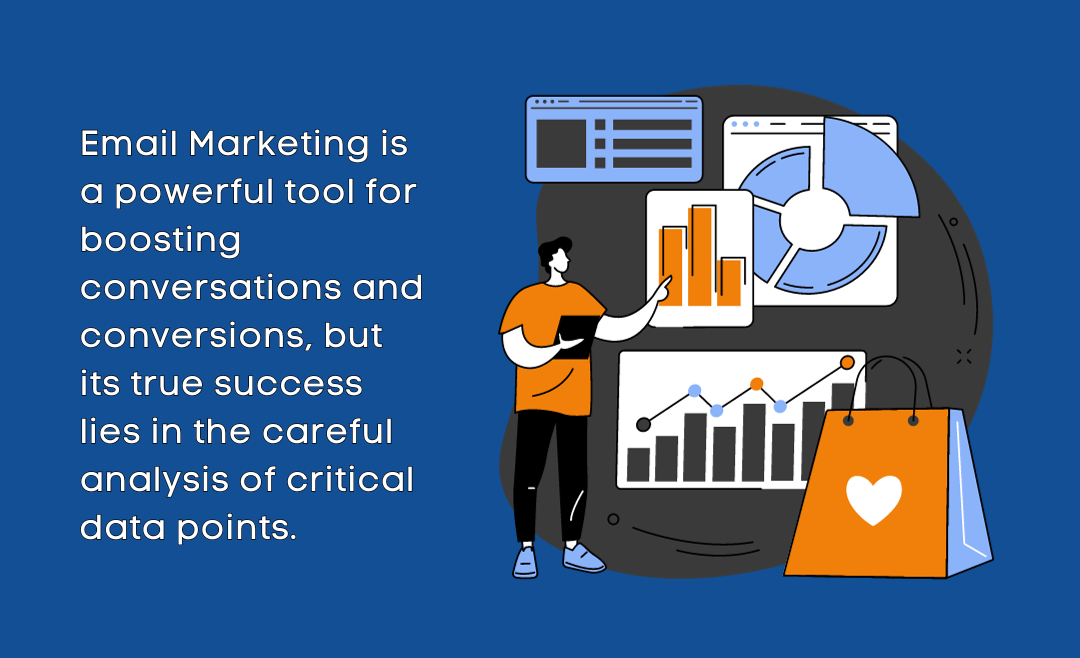Email Marketing is an effective and cost-efficient way to maintain communication and promote offers. With the simple click of a button on your website, cold leads get into the loop and can be nurtured into loyal fans without a need for any face-to-face time unless it’s required. That is why we strongly believe in including it in any digital marketing strategy; no matter what the business offers.
But when actively doing it, there comes the question of how to properly measure the success of email marketing. As it’s a task that takes time when it comes to strategizing and executing, it’s important to not overlook what works and what doesn’t.
In this overview, we want to touch on the most important metrics and considerations when it comes to measuring the success of your email marketing…
What is “Success” in Email Marketing?
This is a really good question to ask because the answer isn’t as clear-cut as you might think. It’s easy enough to compare your data to your industry’s averages, but there’s a lot more to consider alongside that. So while it’s noteworthy if you’re meeting or succeeding industry open/click/purchase rates on your emails, you must also look at:
- Are there any campaigns that performed better than others? Further to this, what was different about the subject lines, content, and links?
- Is there a particular focus (presenting a limited time offer, promoting an item or service, or showcasing a workshop/event) that tends to garner more action?
- Do you see a trend of higher click rates and/or lower unsubscribe rates on shorter or longer emails?
- Where – on the email – are the links that are being clicked?
The questions could go on… but let’s get into why you need to pay attention to seemingly small items like these to determine your most successful email campaigns.
What is a “Successful Email Campaign”?
Before we get into the details, it’s important to point out that the answers are not universal. Your email campaigns – and their measurements of success – will be unique to you. What works well for you isn’t always going to be successful for another business.
Like marketing in general, it will take some experimentation to find what resonates with your audience. This is important because if your audience doesn’t like what they’re receiving, your Open and Click Rates can drop, and your Unsubscribe Rate can climb.
Nobody likes facing these statistics. This is why it’s important to remind yourself that it isn’t always about what you want to say or do, it’s about how to captivate and convert your audience.
In this context: Your audience is everyone on your subscriber list. This could very well be a mix of clients, supporters of your business, as well as potential clients (those people who subscribed but have yet to do any business with you).
With this in mind, you know that there needs to be at least 2 different approaches to email marketing: One that consistently engages with loyal fans, and one that nurtures potential clients.
Even with that said, you should consider segmenting this even further to take advantage of how hot/warm/cold your audience is…
For example: If after sending X campaigns you see certain subscribers open every email and almost always click links; you most definitely want to target these people as often as possible. Using this strategy, you could very well maintain an average Open Rate that’s well over 50%. But then, let’s say, you want to select the highest-performing campaign focus and send it to everyone who rarely opens your emails; it’s quite possible the Open Rate could be half (or less) than what you usually see. But knowing your strategy here, how would you compare the two?
Just give this some thought because the answer isn’t simple. You’re working on two different strategies here. Even though your Open Rate might be significantly lower when you purposely target the segment of your audience that rarely engages, it might be considered a success in comparison to those subscribers’ previous actions. Something as simple as getting people to open your emails if they haven’t in X months can be considered a ‘win’.

There are several different email marketing platforms available with features that can aid you with your strategy. It helps to investigate all of these platforms and choose the most appropriate one for you.
What are Email Marketing “Best Practices”?
This is the area that requires experimentation until you see a consistently positive response. But here’s what you should keep in mind for the approach:
- Try different template layouts (with variations of your branding colours) until you find one that gets more action. This seems irrelevant, but it can make a big difference if you stick to the template that gets the most Clicks, Replies, or Purchases (if the latter action applies).
- Make Subject Lines short, clear, and action-driven. Having a long subject line might mean not everyone will read it. Making it sound too pushy can cause people to either purposely ignore the email or only open it to unsubscribe. This also goes to say that having a spammy-looking subject line can also cause your email to go straight into subscribers’ Junk/Spam folder.
- Use buttons instead of text links for your CTA. It’s acceptable to have links in your copywriting, but research has shown that people more often click on buttons instead of text links. Further to this, using buttons throughout the email (even when they’re all going to the same link) is more user-friendly as it allows readers the opportunity to take action even if they don’t read the entirety of the email.
- Minimize your use of images. Images are great, but having too many can cause issues. Not all email platforms work the same, and if an email takes too long to load because it can’t display all your images quickly enough, the user won’t have the experience with it that you had intended. Some Inboxes – ones that are designed, or catered, to purposely block ads – might not display any images. So the short-winded takeaway is to only use images sparingly for aesthetic purposes, and ensure your text embodies the full message you’re trying to convey.
- Don’t make your emails too long. This can be easy to overlook because when you’re working on an email in the editor, it will Preview the full version without issue. But there are a lot of email systems that will cut emails off at a certain length no matter what. Readers are forced to click a link – which opens the full version of the email in a browser – to read past the cut-off point. Depending on what you’re trying to say or promote, this could turn subscribers away from your emails. It’s also possible for emails to bounce if they’re too long. This should also be a consideration when it comes to image-use as well.
Not sure what to make of this yet?
Do A/B or Multivariate testing if your email marketing platform plan allows it.
The results of a couple of campaigns done this way will give you a clearer picture of how to proceed.
Want more facts to back this up? Have a look at what we’ve experimented with:
- For one email campaign that we wanted all of our clients to read: We dropped the template, made it a plain text email without images, used Merge tags to insert everyone’s name in the content, and used a subject line as if it were a personal email. Not only did it have a higher Open and Click Rate than any of the previous emails we had sent, but it drove a lot of immediate action. In fact, one person picked up the phone and called us about it before reading the email.
- When we wanted to help one of our clients lower their unsubscribe rate and boost open rates: In this case, the client had a high number of unsubscribes after sending long-form email newsletters. Further to this, the Open Rate was down to nearly 14%. We proceeded with their email marketing by sending each item [from the newsletters] as individual campaigns, all with clear subject lines as appropriate. This brought their Open Rates back up and minimized the Unsubscribe Rate. After a few campaigns, we started segmenting all the campaigns based on subscriber behaviours – which resulted in an average Open Rate of 52.3%, an average Unsubscribe Rate of 0.2%, and they are getting an average Click Rate of 4.7% (which is an improvement over the previous 0.1% Click Rate).
- In the case of promoting a service which garnered no response in a previous campaign: We had previously found that a copy format of the service overview with statistical facts and a client testimonial worked wonders, but in this case, it didn’t produce any conversion. So we changed the template design to 2 solid colours, eliminated the image from the body, kept the copy to a total of 6 sentences, and placed the CTA button in the header as well as at the bottom of the body. All of the Clicks that happened on this email occurred on the button that was placed at the top of the email. Further to that, we also had people replying to the email.
How to Measure YOUR Success in Email Marketing
As you have likely gathered from reading all of the above, there’s no single or simple formula for this. You can devise a measurement that makes sense to you, but note that it’s open to your interpretation and should be based more on what works to convert. If you use email marketing to maintain open communications and aren’t expecting sales to come from those emails, then simply focusing on your Open Rates may be enough. But if your email marketing goal is to increase sales, then you need to consider each strategy you implement and how each campaign has performed.
Take our company for example: We only started doing email marketing for ourselves in 2022. Being a small company that has grown on word of mouth, it wasn’t considered a priority to do it before. We eased into it since our clients weren’t used to receiving emails from us. We kept it infrequent, mostly conversational (ie. letting people know about changes to the company or services), and haven’t heavily pushed sales.
But now, when we do send an email promoting a service, we get conversations started. This has resulted in us providing many new project quotes; most of which turned into sales. So our approach had us not getting hung up on the data alone; because we consider it a “success” every time someone reaches out immediately after reading an email. Having said that, we proceed with each campaign using what we know about the data on our most successful campaigns.
This also goes to say that if you’re like us – wherein we used to think we didn’t need email marketing – then maybe it’s time to reconsider.
The biggest takeaway that we can give you is to not give up on it, and continue to experiment as time goes on. But possibly even more importantly than that: Make sure there are clear opportunities to grow your subscriber list. Growing your subscriber list should work in tandem with your overall marketing strategy because conversion can come when you least expect it as long as you maintain your efforts.
Need assistance with your small business’s digital marketing needs? See what we can do here. You can contact us anytime to have a consultation call via Zoom, and we’ll put together a project quote that suits your needs and budget.
